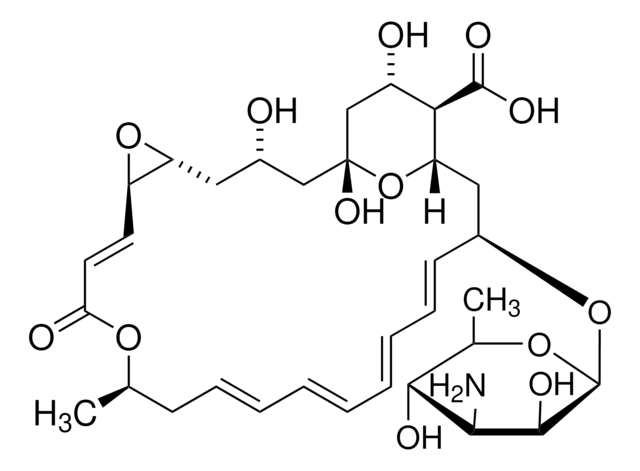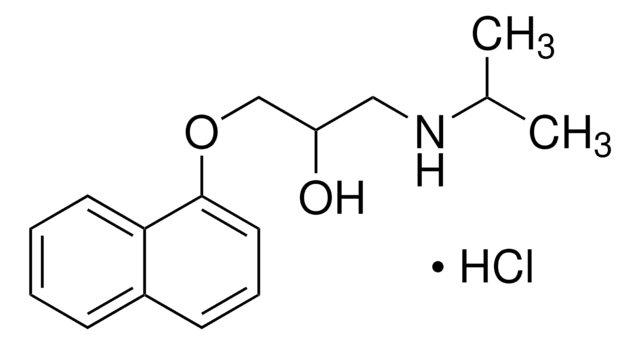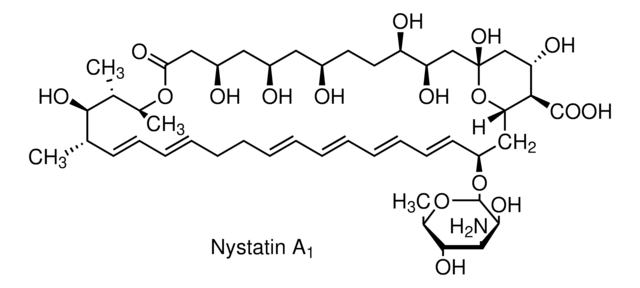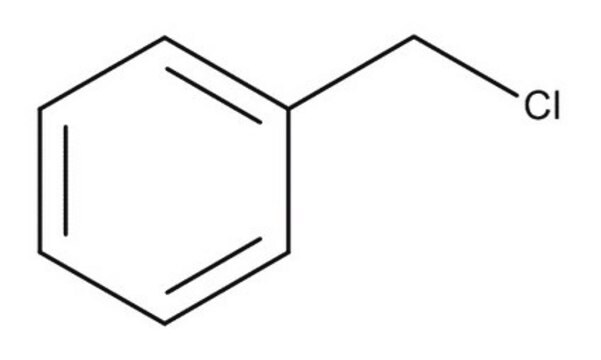P0440
Pimaricin preparation
~2.5% (γ-irradiated Pimaricin), aqueous suspension
Sinónimos:
Pimaricin, Tennecetin, Natamycin preparation
About This Item
Productos recomendados
form
aqueous suspension
concentration
~2.5% (γ-irradiated Pimaricin)
solubility
DMSO: soluble
density
1.0 g/mL at 20 °C (lit.)
antibiotic activity spectrum
fungi
yeast
mode of action
cell membrane | interferes
storage temp.
2-8°C
SMILES string
[H][C@]12C[C@@H](O[C@@H]3O[C@H](C)[C@@H](O)[C@H](N)[C@@H]3O)\C=C\C=C\C=C\C=C\C[C@@H](C)OC(=O)\C=C\[C@@]4([H])O[C@]4([H])C[C@H](O)C[C@](O)(C[C@H](O)[C@H]1C(O)=O)O2
InChI
1S/C33H47NO13/c1-18-10-8-6-4-3-5-7-9-11-21(45-32-30(39)28(34)29(38)19(2)44-32)15-25-27(31(40)41)22(36)17-33(42,47-25)16-20(35)14-24-23(46-24)12-13-26(37)43-18/h3-9,11-13,18-25,27-30,32,35-36,38-39,42H,10,14-17,34H2,1-2H3,(H,40,41)/b4-3+,7-5+,8-6+,11-9+,13-12+/t18-,19-,20+,21+,22+,23-,24-,25+,27-,28+,29-,30+,32+,33-/m1/s1
InChI key
NCXMLFZGDNKEPB-FFPOYIOWSA-N
¿Está buscando productos similares? Visita Guía de comparación de productos
General description
Pimaricin is a polyene antifungal antibiotic produced by Streptomyces natalensis from soil near Pietermaritzburg, South Africa.1 Pimaricin has antimicrobial activity similar to that of nystatin. In addition, it is active against Trichomonas vaginalis. Pimaricin is used in the treatment of candidiasis, trichomoniasis, fungal keratitis and aspergillosis. It has also been used as a food additive in some countries. In some studies, it has been shown to decrease the amount of mold upon which the Dermatophagoides pteronyssinus (house-dust mite) is dependent.2
Application
Biochem/physiol Actions
Preparation Note
The product and any aqueous dilutions will be suspensions and should not be sterile filtered.
Storage and Stability
Other Notes
Storage Class
10 - Combustible liquids
wgk_germany
WGK 2
flash_point_f
Not applicable
flash_point_c
Not applicable
ppe
Eyeshields, Gloves
Elija entre una de las versiones más recientes:
¿Ya tiene este producto?
Encuentre la documentación para los productos que ha comprado recientemente en la Biblioteca de documentos.
Los clientes también vieron
Nuestro equipo de científicos tiene experiencia en todas las áreas de investigación: Ciencias de la vida, Ciencia de los materiales, Síntesis química, Cromatografía, Analítica y muchas otras.
Póngase en contacto con el Servicio técnico






